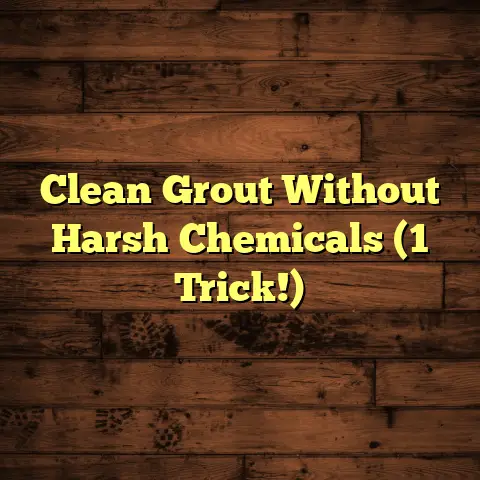How To Keep Wood Floors Shiny? (8 Buffing Tips!)
Ever walked into your home and felt like your wood floors just weren’t sparkling like they used to?
I get it.
That radiant shine that once greeted you now seems…gone.
It’s a common frustration, but don’t worry!
I’m here to tell you that bringing back that luster is totally achievable.
We’re going to dive into 8 essential buffing tips that’ll not only restore
your floors’ brilliance but also help them last longer.
Ready to get started?
Section 1: Understanding Wood Floors
1. Types of Wood Floors
Okay, let’s talk wood.
Not all wood floors are created equal, and knowing what
you’re dealing with is half the battle.
Solid Hardwood: This is the real deal – planks made from a single piece
of wood.
They’re gorgeous, durable, and can be refinished multiple times.
Think oak, maple, and cherry.Engineered Wood: These are made of multiple layers, with a thin layer
of real wood on top.
They’re more stable than solid hardwood, especially
in humid environments, and often more budget-friendly.Laminate: This isn’t actually wood at all!
It’s a synthetic material
that looks like wood.
It’s super durable and easy to clean, but you
can’t refinish it like real wood.
The type of finish on your floor also matters. Here are some common ones:
Polyurethane: This is a super common, durable finish that protects
against scratches and moisture.
It comes in different sheens, from matte
to high-gloss.Oil-Based Finishes: These penetrate the wood, giving it a natural look
and feel.
They require more maintenance than polyurethane but are easier
to spot-repair.-
Wax Finishes: These provide a beautiful sheen but are the least
durable and require regular waxing.
Knowing your floor type and finish is crucial because it dictates the products
and techniques you can use.
Using the wrong product can damage your floor,
so always check the manufacturer’s recommendations!
2. The Importance of a Shine
Why bother with a shiny floor, you ask?
Well, besides looking fantastic, a
good shine actually protects your floors.
Here’s why it matters:
Aesthetic Appeal: Let’s be honest, a shiny floor just looks good!
It
reflects light, making your room feel brighter and more inviting.Scratch Protection: A good finish acts as a barrier against everyday
wear and tear.
The shinier the finish, the better it deflects minor
scratches and scuffs.Home Ambiance: Your floors set the tone for your entire home.
Shiny
floors give a sense of cleanliness and sophistication.-
Increased Home Value: Well-maintained, shiny wood floors can increase
the value of your home.
Think of it this way: your floor is like a canvas, and the finish is like
the protective coating on a painting.
You want that coating to be strong and
beautiful!
Section 2: Preparing for Buffing
3. Gathering the Right Tools and Materials
Alright, let’s get practical.
To buff your floors like a pro, you’ll need
the right tools and materials.
Here’s my go-to list:
Floor Buffer: This is the big kahuna.
You can rent one from most
hardware stores.
Look for one with adjustable speed settings.Buffing Pads: These come in different grits, from coarse to fine.
You’ll need a few different pads depending on the condition of your
floors and the level of shine you want to achieve.
Here’s a quick guide:- Coarse Pad: For removing old finishes or heavy scratches.
- Medium Pad: For general buffing and polishing.
- Fine Pad: For final polishing and achieving a high shine.
Wood Floor Cleaner: Choose a cleaner specifically designed for wood
floors.
Avoid harsh chemicals like bleach or ammonia, which can damage
the finish.-
Wood Floor Polish: This adds a protective layer and enhances the shine.
Again, choose a polish that’s compatible with your floor’s finish. -
Microfiber Mop and Cloths: These are essential for cleaning and
applying polish. -
Vacuum or Broom: For removing loose dirt and debris.
-
Safety Glasses and Gloves: Protect your eyes and hands!
Pro Tip: Always test your products in an inconspicuous area first to make sure they don’t damage your floor.
4. Cleaning Before Buffing
This is the most important step.
You can’t buff dirty floors!
Buffing over
dirt and debris will just grind it into the finish, causing scratches.
Here’s my cleaning routine:
Vacuum or Sweep: Remove all loose dirt, dust, and debris.
Pay special
attention to corners and edges.Mop with Wood Floor Cleaner: Use a microfiber mop and a wood floor
cleaner.
Don’t over-saturate the floor – you want it damp, not soaking wet.-
Rinse (Optional): If your cleaner leaves a residue, rinse the floor
with clean water. Dry Thoroughly: Let the floor dry completely before buffing.
This
usually takes a few hours.
Why is this so important? Think of it like this: you wouldn’t wax a dirty
car, would you?
Same principle applies to your floors.
A clean surface is
essential for achieving a smooth, shiny finish.
Section 3: 8 Buffing Tips for Shiny Wood Floors
Okay, now for the main event!
Here are my top 8 buffing tips for achieving
those envy-worthy shiny wood floors:
5. Tip 1: Choose the Right Buffing Method
You’ve got a couple of options here:
Floor Buffer: This is the most efficient way to buff large areas.
It’s
faster and more consistent than hand-buffing.
However, it can be a bit
intimidating to use at first.Hand-Buffing: This involves using a buffing pad attached to a pole or
your hand.
It’s great for small areas or touch-ups.
It’s also a good
option if you’re not comfortable using a floor buffer.
Pros and Cons:
My Recommendation: If you have a large area to buff, rent a floor buffer.
Just watch some tutorials and practice in an inconspicuous area first.
If
you’re just doing a small area or touch-ups, hand-buffing is perfectly fine.
6. Tip 2: Use the Correct Buffing Pad
As I mentioned earlier, buffing pads come in different grits.
Here’s how to
choose the right one:
-
For Removing Old Finishes or Heavy Scratches: Start with a coarse pad.
This will remove the top layer of the finish and smooth out any imperfections. For General Buffing and Polishing: Use a medium pad.
This will refine
the surface and prepare it for polishing.-
For Final Polishing and Achieving a High Shine: Finish with a fine pad.
This will bring out the shine and give your floors a smooth, glossy finish.
Important: Always start with the least aggressive pad possible and work
your way up.
You don’t want to damage your floor by using a pad that’s too
coarse.
7. Tip 3: Apply a Quality Wood Floor Polish
This is where the magic happens!
A good wood floor polish will protect your
floors and enhance their shine.
Here are some of my favorite brands:
-
Bona: A well-known brand with a range of polishes for different types
of wood floors. -
Rejuvenate: A popular choice for restoring shine to dull floors.
-
Weiman: A good option for cleaning and polishing in one step.
How to Apply Polish:
-
Read the Instructions: Always follow the manufacturer’s instructions.
Apply a Thin, Even Coat: Use a microfiber mop or cloth to apply a thin,
even coat of polish.
Avoid applying too much polish, which can leave a
sticky residue.Let it Dry: Allow the polish to dry completely before walking on the
floor.
This usually takes 30-60 minutes.-
Buff (Optional): For an extra shine, you can buff the floor with a
fine pad after the polish has dried.
8. Tip 4: Regular Buffing Schedule
How often should you buff your floors? It depends on a few factors:
-
Foot Traffic: High-traffic areas will need to be buffed more often than
low-traffic areas. -
Pets: Pets can scratch and wear down the finish on your floors, so
you may need to buff more frequently. -
Lifestyle: If you have kids or entertain often, your floors will likely
need more frequent buffing.
General Guidelines:
- High-Traffic Areas: Buff every 1-2 months.
- Medium-Traffic Areas: Buff every 3-4 months.
- Low-Traffic Areas: Buff every 6-12 months.
Spot Buffing: Don’t forget to spot-buff areas that get a lot of wear and tear, like entryways and hallways.
9. Tip 5: Avoiding Common Mistakes
Here are some common mistakes people make when buffing their wood floors:
-
Not Cleaning Thoroughly: As I mentioned earlier, this is the biggest
mistake! -
Using the Wrong Products: Always choose products that are specifically
designed for wood floors and compatible with your floor’s finish. -
Applying Too Much Polish: This can leave a sticky residue and make your
floors look dull. -
Using the Wrong Buffing Pad: Start with the least aggressive pad
possible and work your way up. -
Buffing Too Aggressively: Don’t press down too hard on the buffer,
which can damage the finish. -
Not Wearing Safety Gear: Protect your eyes and hands!
10. Tip 6: Use a Microfiber Cloth for Touch-ups
Between buffing sessions, use a microfiber cloth to quickly touch up any
scuffs or dull spots.
Just dampen the cloth with a little water and gently
rub the affected area.
This will help maintain the shine and prevent dirt
from building up.
11. Tip 7: Addressing Scratches and Dullness
Got deeper scratches or dull areas that need some extra love?
Here’s what
I recommend:
For Minor Scratches: Use a scratch repair pen or a wood filler that
matches your floor’s color.
Apply the product to the scratch and wipe away
any excess.-
For Dull Areas: Try using a revitalizing wood floor cleaner or polish.
These products are designed to restore shine to dull floors. For Severe Damage: If your floors are severely damaged, you may need
to refinish them.
This involves sanding down the old finish and applying
a new one.
It’s a bigger job, but it can completely transform your floors.
12. Tip 8: Seasonal Care Tips
Your wood floors need different care depending on the season.
Here’s what
to keep in mind:
Winter: Winter air is dry, which can cause wood floors to shrink and
crack.
Use a humidifier to maintain a consistent humidity level in your
home.-
Spring: Spring brings moisture, which can cause wood floors to swell.
Make sure to clean up any spills immediately and avoid over-wetting your
floors when cleaning. Summer: Summer heat can cause wood floors to fade.
Use curtains or
blinds to protect your floors from direct sunlight.-
Fall: Fall brings leaves and dirt into your home, so make sure to
sweep or vacuum regularly.
Conclusion: Embracing the Challenge
Maintaining shiny wood floors can feel like a challenge, but it’s totally
worth it!
By following these 8 buffing tips and incorporating them into your
regular cleaning routine, you can keep your floors looking their best for
years to come.
Remember, a little effort goes a long way.
So, embrace the challenge, grab
your buffer, and get ready to transform your floors from dull to dazzling!
Good luck, and happy buffing!





